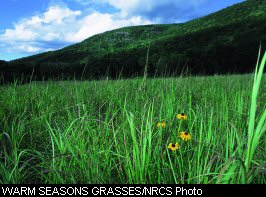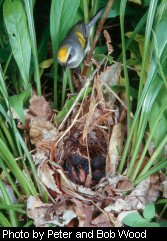

West Virginia 's Wildlife Conservation and Restoration ProgramBy Kathy Leo
Congress appropriated the federal funds at the urging of the Teaming With Wildlife Coalition, made up of over 3,000 conservation organizations and businesses across the nation. Our West Virginia Teaming With Wildlife Coalition consists of 51 organizations and is still growing. This is a very exciting era for some of the state's lesser-known species, as this dedicated funding will ensure that attention is paid to creatures before they become endangered. West Virginia WCRP projects are divided in three categories: Conservation, Education and Recreation. Conservation Native Perennial Plant Management on Wildlife Management Areas. Wildlife managers have long recognized the need to create low-maintenance wildlife habitats on state managed lands. Several hundred acres on selected WMAs have been planted with native warm and cool season grasses, legumes and shrubs that provide food as well as nesting, winter and escape cover for a diversity of wildlife. Henslow's sparrows, grasshopper sparrows and meadowlarks benefit from the cover provided by warm season grasses. In addition, field sparrows, slate-colored juncos and cardinals can eat the seeds produced from these plantings. Redwing blackbirds, meadowlarks and field sparrows use cool season grasses as nesting cover, and meadow voles and several species of mice use these grasses as food. Partners In Flight. The West Virginia Partners in Flight working group was formed in 1994 and is composed of individuals from universities, state and federal government agencies, conservation groups and businesses. They are committed to the conservation of wild birds and their habitats through management, research, monitoring, and public information and education. In this project, a statewide system of bird point counts is being established. Currently there are 147 routes in 53 counties. Thus far, bird point counts are conducted in 29 of the 69 WMAs, with plans to establish routes in all of them. This information will help biologists to estimate bird populations as well as establish baseline numbers that will alert us to any changes in bird populations that may require conservation action. A songbird Herpetological Atlas. Dr. Thomas K. Pauley is completing the state's first herpetological atlas that will form the basis of the second edition of the popular but now out-of-print field guide, Amphibians and Reptiles in West Virginia . The atlas, which will outline the distribution of amphibians and reptiles in the state, will be available in 2005. WCRP funds have also been used to study the life history of selected species as well as gather distribution information. Specifically, turtle distribution was studied in 10 major river systems of the state. Important Bird Areas Program. Data from nearly 40 years of Breeding Bird Surveys indicate that bird populations are declining across North America , and for many species, these declines are precipitous. While data from West Virginia show declines, most are less severe than the national trends. Because of the comparatively large populations of some of these birds in West Virginia , researchers from eastern states feel that West Virginia may provide source populations for bird species that have declined significantly in the region. Thus, it is imperative that West Virginia takes steps now to conserve these species. Important Bird Areas will serve as places for bird conservation, for monitoring and research activities, and for public education. A technical committee has been formed, and stakeholders will nominate sites around the state. The committee will select sites on science-based criteria to maximize bird conservation. In the future, once sites are identified, signs and a guide to the areas will be produced to make the public aware of their existence. Education Publications. The Mushrooms of West Virginia and the Central Appalachians by William C. Roody is a general identification guide to the mushrooms of this region. It features descriptions and beautiful color photographs of nearly 400 species. About 800 copies were donated to schools, public libraries, and university and college libraries throughout the state. Funds from WCRP also paid for the publication of five issues of West Virginia Wildlife magazine. Several brochures have been reprinted and new booklets on West Virginia tiger beetles and salamanders created. Educational Displays and Presentations. The Wildlife Diversity Program has several colorful and interactive educational displays for use at public functions. WCRP funding was used to update these and create new ones. In addition, staff are often called upon to give presentations across the state. New PowerPoint presentations are being developed on a variety of topics for distribution to DNR biologists for educational presentations. Interpretive Enhancements at the West Virginia State Wildlife Center at French Creek. New educational signs now grace the outdoor animal exhibits at the Center. A pond has been created complete with an observation platform. A new interpretive trail winds through 80 acres of beautiful old growth forest. School classes can use a new outdoor amphitheater and visitors can check out the new snake exhibit. Recreation Greenbottom Wildlife Management Area. Greenbottom WMA located near Huntington encompasses nearly 1,200 acres. Stretching along the banks of the Ohio River , this area contains 300 acres of forest, 180 acres of wetlands, 680 acres of agricultural land, and 40 acres of open water. The habitats of Greenbottom WMA support a wide array of wildlife, including 30 species of mammals, 105 species of birds in the summer and fall and 47 in the winter, 12 species of amphibians, and 5 species of reptiles. A boardwalk and observation platform that give an excellent view of the marshes have been constructed. Using a new educational booklet, visitors can take a self-guided tour. These are just a few of the many new opportunities made available to West Virginians who appreciate and enjoy our rich natural heritage. For more information, contact Kathy Leo at: DNR Wildlife Resources, P.O. Box 67, Elkins, WV 26241, phone: 304-637-0245 or email: kathyleo@wvdnr.gov. Kathy Leo is the Wildlife Diversity Program Coordinator. |
 Despite more than a century of conservation work, much still remains to be done to ensure that all wildlife species will exist for future generations. In response to this challenge, Congress appropriated $50 million nationwide in 2001 for the Wildlife Conservation and Restoration Program (WCRP). West Virginia 's share of this funding is $483,000. Projects must involve wildlife species with the greatest conservation need. Because these projects require a 25 percent match of state funds, the actual total spent on projects amounts to $670,000. The match comes from the sale of rose-breasted grosbeak and white-tailed deer wildlife license plates.
Despite more than a century of conservation work, much still remains to be done to ensure that all wildlife species will exist for future generations. In response to this challenge, Congress appropriated $50 million nationwide in 2001 for the Wildlife Conservation and Restoration Program (WCRP). West Virginia 's share of this funding is $483,000. Projects must involve wildlife species with the greatest conservation need. Because these projects require a 25 percent match of state funds, the actual total spent on projects amounts to $670,000. The match comes from the sale of rose-breasted grosbeak and white-tailed deer wildlife license plates.  management guide will be available later this year from the DNR Wildlife Resources Section to help landowners make timber management decisions that benefit songbirds.
management guide will be available later this year from the DNR Wildlife Resources Section to help landowners make timber management decisions that benefit songbirds.